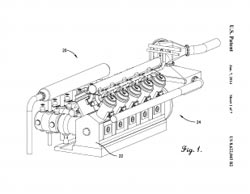Patented Airflow System Decreases Pollutants From Large Piston Engines

Kansas State University<br><br>Figure of the air control system from the patent paperwork.<br>
The system enables large-bore, multi-cylinder engines used in trains, pipelines, backup diesel generators and other fields to run efficiently while producing lower levels of harmful emissions than they do currently.
The patent, “Active Air Control,” was issued to the Kansas State University Research Foundation, a nonprofit corporation responsible for managing technology transfer activities at the university. The patent is for research by former faculty member Kirby Chapman and doctoral graduate Diana Grauer.
The Kansas State University-developed system uses an airflow sensor to measure and control the airflow rate into each piston in real time. Algorithms adjust the airflow accordingly and equalize the rate in multiple cylinders at the same time. This reduces the levels of nitrogen oxides produced during combustion in the engine.
The air control system offers a low-cost method to control and lower the production of nitrogen oxides and helps legacy engines meet compliance with EPA 2011 regulations. The system also was designed to fit various engine systems.
Kansas State University currently holds 100 active patents in its portfolio.
Media Contact
More Information:
http://www.k-state.eduAll latest news from the category: Machine Engineering
Machine engineering is one of Germany’s key industries. The importance of this segment has led to the creation of new university degree programs in fields such as production and logistics, process engineering, vehicle/automotive engineering, production engineering and aerospace engineering among others.
innovations-report offers informative reports and articles covering technologies such as automation, motion, power train, energy, conveyor, plastics, lightweight construction, logistics/warehousing, measurement systems, machine tools and control engineering.
Newest articles

Parallel Paths: Understanding Malaria Resistance in Chimpanzees and Humans
The closest relatives of humans adapt genetically to habitats and infections Survival of the Fittest: Genetic Adaptations Uncovered in Chimpanzees Görlitz, 10.01.2025. Chimpanzees have genetic adaptations that help them survive…

You are What You Eat—Stanford Study Links Fiber to Anti-Cancer Gene Modulation
The Fiber Gap: A Growing Concern in American Diets Fiber is well known to be an important part of a healthy diet, yet less than 10% of Americans eat the minimum recommended…

Trust Your Gut—RNA-Protein Discovery for Better Immunity
HIRI researchers uncover control mechanisms of polysaccharide utilization in Bacteroides thetaiotaomicron. Researchers at the Helmholtz Institute for RNA-based Infection Research (HIRI) and the Julius-Maximilians-Universität (JMU) in Würzburg have identified a…



